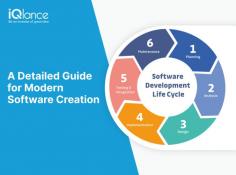Developing exceptional software applications is no small feat. At iQlance Solutions, a leading software development company Dallas with over years of experience, we understand the critical role a well-defined Software Development Life Cycle (SDLC) plays in achieving success. This comprehensive guide dives deep into the intricacies of SDLC in 2024, exploring the latest trends, best practices, and how it can empower you to build high-quality, future-proof software solutions.
What is the Software Development Life Cycle (SDLC)?
The SDLC is a structured framework that outlines the entire software development process, from initial concept to deployment and ongoing maintenance. It serves as a roadmap, ensuring each stage is meticulously planned, executed, and reviewed before moving to the next. This methodical approach minimizes risk, fosters efficiency, and ultimately leads to the creation of robust, user-centric software.
Why is a Robust SDLC Essential in 2024?
The software development landscape of 2024 is characterized by several key trends that necessitate a strong SDLC:
Exponential Growth of Mobile Apps: With mobile app usage soaring, businesses need a streamlined and adaptable SDLC to deliver high-performing apps quickly and efficiently.
Focus on User Experience (UX): In today’s competitive landscape, exceptional user experience is paramount. An SDLC that prioritizes user research, testing, and feedback iteration is vital for crafting user-friendly software.
Rapid Technological Advancements: The software development world is constantly evolving with new technologies like artificial intelligence (AI), blockchain, and the Internet of Things (IoT) emerging. A flexible SDLC allows for the seamless integration of these advancements into software solutions.
Cybersecurity Concerns: Data breaches and cyberattacks are a growing threat. A robust SDLC with robust security measures at every stage is crucial for building secure software that protects user data.
Shift Towards Cloud-Based Solutions: With the increasing popularity of cloud computing, SDLCs need to adapt to accommodate the unique challenges and opportunities associated with cloud deployment.


